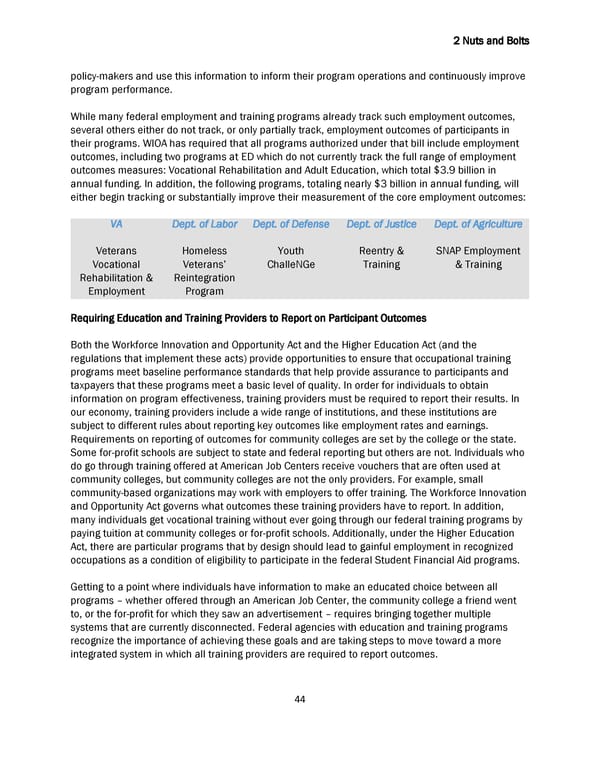2 Nuts and Bolts policy-makers and use this information to inform their program operations and continuously improve program performance. While many federal employment and training programs already track such employment outcomes, several others either do not track, or only partially track, employment outcomes of participants in their programs. WIOA has required that all programs authorized under that bill include employment outcomes, including two programs at ED which do not currently track the full range of employment outcomes measures: Vocational Rehabilitation and Adult Education, which total $3.9 billion in annual funding. In addition, the following programs, totaling nearly $3 billion in annual funding, will either begin tracking or substantially improve their measurement of the core employment outcomes: VA Dept. of Labor Dept. of Defense Dept. of Justice Dept. of Agriculture Veterans Homeless Youth Reentry & SNAP Employment Vocational Veterans’ ChalleNGe Training & Training Rehabilitation & Reintegration Employment Program Requiring Education and Training Providers to Report on Participant Outcomes Both the Workforce Innovation and Opportunity Act and the Higher Education Act (and the regulations that implement these acts) provide opportunities to ensure that occupational training programs meet baseline performance standards that help provide assurance to participants and taxpayers that these programs meet a basic level of quality. In order for individuals to obtain information on program effectiveness, training providers must be required to report their results. In our economy, training providers include a wide range of institutions, and these institutions are subject to different rules about reporting key outcomes like employment rates and earnings. Requirements on reporting of outcomes for community colleges are set by the college or the state. Some for-profit schools are subject to state and federal reporting but others are not. Individuals who do go through training offered at American Job Centers receive vouchers that are often used at community colleges, but community colleges are not the only providers. For example, small community-based organizations may work with employers to offer training. The Workforce Innovation and Opportunity Act governs what outcomes these training providers have to report. In addition, many individuals get vocational training without ever going through our federal training programs by paying tuition at community colleges or for-profit schools. Additionally, under the Higher Education Act, there are particular programs that by design should lead to gainful employment in recognized occupations as a condition of eligibility to participate in the federal Student Financial Aid programs. Getting to a point where individuals have information to make an educated choice between all programs – whether offered through an American Job Center, the community college a friend went to, or the for-profit for which they saw an advertisement – requires bringing together multiple systems that are currently disconnected. Federal agencies with education and training programs recognize the importance of achieving these goals and are taking steps to move toward a more integrated system in which all training providers are required to report outcomes. 44
 Biden Ready to Work White Paper 7/22/14 Page 43 Page 45
Biden Ready to Work White Paper 7/22/14 Page 43 Page 45